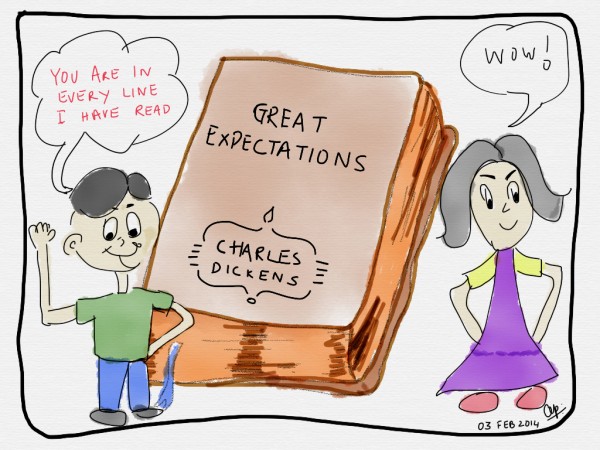It took me more than an year to read ‘Great Expectations’… but then I was in school then and more fascinated with Bigglesworth, Gimlet, and the Famous Five. I read somewhere that this book was published as a novel in three volumes in 1861… and I said to myself, ‘Wow! No wonder it took me an year to read it the first time.’
This book appeared much tougher than the fairy tales I read that had almost the same ingredients. A lonesome boy, a girl, adventures in the marshes, a convict, magical appearance of a benefactor, good life in London, riches… well, the book doesn’t really end as fairy tales do. With all its schizophrenic dichotomies of characters it would never be cleared as a fairy tale by the Grimm brothers, I’m sure.
What I loved about the book was the way the school boy in me identified with Pip… and it isn’t just because even I was fond of bolting my food but because beautiful girls sent me too in raptures. So I loved imagining the mothers of all these lovely girls in small-town Jhansi as somewhat similar to Miss Havisham and muttering:
‘Love her, love her, love her! If she favours you, love her. If she wounds you, love her. If she tears your heart to pieces – and as it gets older and stronger, it will tear deeper – love her, love her, love her!’
No, I didn’t quite understand the implications of these lines but just loved them for the lilt that my mind perceived in them. But now that I have read the book two more times, I know what Dickens was talking about. I know why the book is considered representative of pre-industrial, ‘village’ labor as well as representative of feudal aristocracy. I can now appreciate the way Dickens went about describing the ‘abject poverty, decadence, and criminal malevolence of those at Smithfield and Newgate’ and a middle class then that was confused and never at peace.
I now know why this novel by Charles Dickens is also called a bildungsroman… Yes, it is all the meandering through love and passion, dealing with mysterious twists, and all the coming face-to-face with social truths that portrays the psychological development of Pip, the central character. Pip has a life that is made up of ‘so many partings welded together’ and so is the case with other lives in this novel. The novel explores the village poor and the urban poor, the aristocracy, the working class, and the capitalists… and manages to project a strong criticism of Victorian England. One blogger writes about Dickensian criticism being ‘no less harsh than Karl Marx’s dialectic attack, or Friedrich Nietsche’s epistemological one.’
But listen, one of the foremost reasons I have loved this work of Dickens is the way he brings out the incessant love of Pip for Estella. He appears like one of those incorrigible lovers not destined to learn when he whines about having ‘loved her against reason, against promise, against peace, against hope, against happiness, against all discouragement that could be.’
I have been wondering about the sort of lukewarm reception these literary classics get from the Indian readers. I mean, barring the students of literature (and I know most of this lot too reads these authors through guide-books!) no one else goes beyond the wishy-washy prose that half-baked pulp-fiction writers that are increasing by the dozen, throw at us at throwaway prices! And it is here that the role of book reviewers and bloggers comes in… they must make sure that a part of their focus remains on reviewing classics for their readers to keep them alive and in the reckoning. The readers too need to realise that writers like Dickens don’t just offer a glimpse into the past but also take you by hand through the magical kingdom of exquisite craftsmanship of language!
Good books have ideas and expressions that pulsate with life. It is almost like what Pip said of Estella:
‘You are in every line I have ever read.’
Arvind Passey
Written on: 03 February 2014










6 comments
Meghana Rawat says:
Feb 10, 2014
Loved reading this.. 🙂
Arvind Passey says:
Feb 10, 2014
Yes Meghana, the book has some unforgettable prose. 🙂
Kalpana Solsi says:
Feb 10, 2014
I always felt that the old English classics are in great demand.
and they are available for free on Kindle download.
Arvind Passey says:
Feb 10, 2014
I personally find reading on my Kindle rather difficult… and prefer the printed version always.
Blasphemous Aesthete says:
Feb 11, 2014
There is a certain tenacity that is required to really read classics. It isn’t just the English authors, but the casual Indian reader shies away from our own literature too (though it is very wrong of me to classify literature as own and foreign). Premchand, Rabindranath, Parsayi and many others, they wrote about the Indian societies of their times, and in what beautiful detail, but alas we read the story – we just read it through, like through a looking glass, never glancing at the character that it holds when it spreads those colours into a fine spectrum.
But these books are like poison, like a tigers tooth, once they’re in, nothing really fights back.
Nice post!
Blasphemous Aesthete
Arvind Passey says:
Feb 11, 2014
Classics are like poison… is a rather no-frills explanation and somewhat different from the conventional path. But yes, classics bind you and you helplessly but with a lot of warm love decide to let their heady feeling reign your senses. 🙂